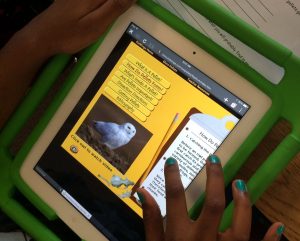 I’d like to clear something up. The emergent curriculum is not a haphazard process. It’s a well respected, research-based approach to authentic learning. The emergent curriculum is generally known for taking into account the interests of children and teachers, developmental tasks, things and people in the environment, unexpected events, and matters that arise from living among other human beings. While it’s often applied in early childhood classrooms , it’s a framework for learning that also works with older kids (http://elsci.coe.nau.edu/docs/mmeredithpaper.pdf). We use the Common Core as the foundation of our Seed elementary curriculum (in our state they’re referred to as Arizona’s College and Career Ready Standards, http://www.azed.gov/azccrs/). One benefit of the standards is that they allow flexibility for how to teach each item. The emergent curriculum is a perfect fit, especially given our creative and innovative teachers. I landed right in the middle of a wonderful example that “emerged” in the 3rd/4th grade class recently.
I’d like to clear something up. The emergent curriculum is not a haphazard process. It’s a well respected, research-based approach to authentic learning. The emergent curriculum is generally known for taking into account the interests of children and teachers, developmental tasks, things and people in the environment, unexpected events, and matters that arise from living among other human beings. While it’s often applied in early childhood classrooms , it’s a framework for learning that also works with older kids (http://elsci.coe.nau.edu/docs/mmeredithpaper.pdf). We use the Common Core as the foundation of our Seed elementary curriculum (in our state they’re referred to as Arizona’s College and Career Ready Standards, http://www.azed.gov/azccrs/). One benefit of the standards is that they allow flexibility for how to teach each item. The emergent curriculum is a perfect fit, especially given our creative and innovative teachers. I landed right in the middle of a wonderful example that “emerged” in the 3rd/4th grade class recently.
Each Wednesday I spend an hour teaching poetry writing to the 3rd/4th grade students. Our recent focus has been on crafting animal poems, using research facts gathered as part of a bigger study of Arizona. As I dug deeper, I learned that students are working in teams to write and illustrate informational books about their chosen Arizona animal for several other classrooms, an idea that evolved from a class discussion. In preparation for this project (and to meet several standards, including W. 4. 4 “produce clear and coherent writing in which the development and organization are appropriate to task, purpose and audience”), students used books, charts and websites to gather their information. They had to consider their audience as they created and published age-appropriate texts about their chosen animals.
The poems were an offshoot of this writing. I invited students to help me brainstorm a list of ideas for a poem I’m writing about an early-morning owl encounter. Following our collaborative list, I suggested they repeat the process with their animal facts, paying close attention to any surprises that arose. What emerged and is still emerging is full of surprise. One student in his yet-to-be-named poem came up with these lines about an owl pellet:
“As the owl swoops down to
catch the fleeing rodent in her razor
talons, she brings it up to her nest
to feast.
Two days later she coughs the bones up.
As we hike by a pond in
Chauncy Ranch, we find the pellets
and as we dissect them I realize
that I’m looking at a menu.”
Poems from the rest of these smart, creative children are still forthcoming. As their emergent curriculum immerses them further into using the menu of Webquest (www.kidwings.com/owlpellets/flash/v4/index.htm) to dissect a virtual owl pellet and eventually an actual one, I am certain their plates will continue to be full of words, questions and explorations selected from the menus of their imaginations. Their curiosity and this unique opportunity for learning to follow their interests will serve them well as they grow into the responsible, caring adults we know they will be.

Thank you for writing about this topic.
I love it! I totally agree.